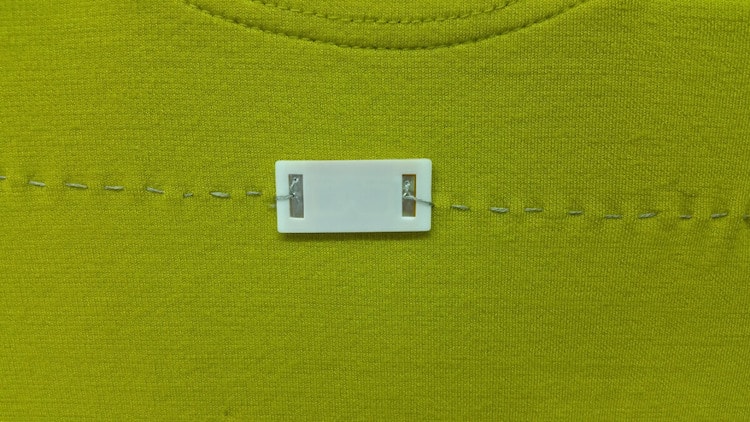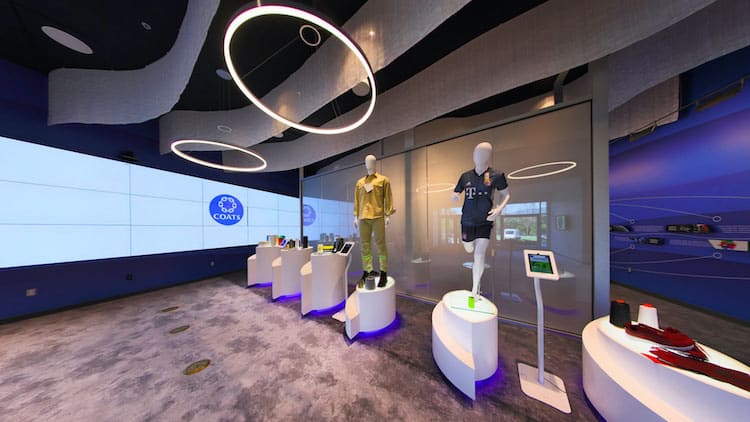Headquartered in Uxbridge, United Kingdom, the world’s largest industrial thread company explores new avenues of technological advances and collaborations

Striving to extend its long legacy of leadership, innovation and collaboration, industrial thread manufacturer Coats has opened three Innovation Hubs in key markets across the globe. They include the new Coats Innovation Hub America site, which the company opened at its Sevier manufacturing facility in Marion, North Carolina, in the fall of 2018.
Designed as places to explore new ideas and technologies, the hubs include a materials lab, where customers can collaborate directly with Coats’ technologists in the idea-generation and creation processes; a prototyping area; and a pilot factory with a full range of the latest machinery that can be used to test and fine-tune manufacturing processes for new products in a controlled, dedicated environment.
AT A GLANCE
Company
Coats Group plc
Headquarters
Uxbridge, United Kingdom, with a workforce of 18,000 in more than 50 countries across six continents. In the United States, it operates three production facilities in King’s Mountain, Hendersonville and Marion, North Carolina, where it also has a new Innovation Hub.
Specialty
Specialty engineered industrial threads and yarns
History
Roots trace back to the founding of Clark Thread Co. in 1755 and a cotton mill founded by James Coats in 1826. In 1896, the two companies merged to form J&P Coats Ltd.
Ownership
Publicly held company traded on the London Stock Exchange
Learn more
“You don’t get to be a 264-year-old company by doing the same things you’ve always done over and over again,” says Tim Meade, sales director for Coats North America. “To keep pace with an ever-changing market, we’ve had to reinvent ourselves many times. We have a deeply rooted commitment to innovation, and that’s what’s enabled us to survive and grow.”
Uxbridge, United Kingdom-based Coats Group plc has opened two additional Innovation Hubs in Bursa, Turkey; and Shenzhen, China. Each of the three hubs has a focus that reflects the nature of Coats’ business in the local market. The Shenzhen-based hub, for example, is charged with developing new products and processes in apparel and footwear, which account for two-thirds of Coats’ sales worldwide.
The North Carolina hub focuses on performance materials for use in household and recreation, personal protection, transportation and infrastructure products. This facility also will serve as a collaboration site for mattress, pillow and ticking manufacturers, and a number of Coats’ bedding customers already have toured the site, according to Meade.
Fostering innovation
“The hubs provide creative and inspiring spaces where an innovative idea can be developed collaboratively and rapidly worked up into a prototype design that then is manufactured in our on-site pilot factory,” Meade says. “Customer-centric innovation is an important part of our growth strategy, and our hubs provide the perfect setting for this creative thinking.”

Customer reaction to the hub has been “fantastic,” he says. “The pilot factory is essentially a standalone production area with a full range of equipment. It enables us to turn samples faster, and in smaller quantities, than is possible in a conventional setting.”
The hub also is proving to be a good place for Coats to showcase other capabilities with its customers. “We are perceived mostly as a thread company, but we also are doing a lot of work in spun yarns and composites,” Meade says. In addition, Coats is becoming more of a solutions provider for manufacturers, offering services relating to time management, materials usage and productivity. In September, it announced the launch of Coats Digital, an integrated technology business that brings together its software solutions under a new single brand.
“Coats Digital marks the beginning of an exciting new age for our software solutions offering,” says Keith Fenner, managing director of Coats Digital. “It provides a clear and distinct focus and establishes that, while Coats continues to be an industrial manufacturing company, we are also innovating technologies of tomorrow to improve how the fashion industry develops, costs, sources and manufactures products sustainably into the future.”
Apparel and footwear will be the first focus, but eventually these services may extend to other industries, such as sleep products.
An integral part of daily life
From conventional consumer products such as mattresses, apparel and footwear to safety-critical industrial applications such as automotive airbags and medical sutures, Coats provides threads and yarns for a highly diverse list of industries. With annual revenues of more than $1.4 billion and a workforce of 18,000 in more than 50 countries on six continents, Coats holds the distinction of being the world’s largest industrial thread company.

The origins of Coats can be traced to the Clark and Coats families, which created the weaving and textile industries of Paisley, Scotland, during the late 18th century. Brothers James and Patrick Clark began their business — a loom equipment and silk thread company — in 1755 in Paisley. In 1806, Patrick Clark invented a way to twist cotton together as a cheaper, more readily available alternative to silk. In 1812, he opened the first plant for manufacturing the cotton thread.
In 1802, James Coats set up a weaving business, also in Paisley. In 1826, he opened a cotton mill in Ferguslie, Scotland, to produce his own thread, and, when he retired in 1830, his sons, James and Peter, took over the business under the name J&P Coats. The firm expanded internationally, and, in 1890, Coats went public with an offering on the London Stock Exchange.
In 1896, the Coats and Clark firms merged, forming J&P Coats Ltd. In 2003, Guinness Peat Group acquired J&P Coats and took it private. Then, in 2015, Coats returned to the London stock market as Coats Group plc.
Global leadership
Throughout its history, Coats has specialized in one core segment: thread and sewing-related products. Over the years, it has been responsible for a long list of innovations and advances in the sewing arena, including the invention of thread suitable for use in the first mechanical sewing machine. But despite its focus on thread and sewing-related products such as zip closures, the company’s culture, product range and capabilities have been continually evolving and responding to ongoing changes in the market.

The acquisition of Patrick Yarn Mill, completed in late 2017 (see sidebar on page 20), strengthens Coats’ already deep presence in the home furnishings market, where it has been the leading supplier of quilting and FR threads. Best-selling current brands include: Coats Protos and Coats Protos Fil, fire retardant sewing threads made from 100% para-aramid continuous filament that mattress manufacturers use to meet federal 16 CRF 1633 mattress burn test requirements; Coats Gral, a specially finished polyester thread made from prestabilized, high-tenacity continuous filament polyester designed for multineedle quilting operations; and Coats Gramax, a 100% polyester continuous filament thread with textured filaments for a soft feel.
“Coats has been supplying thread to many of the world’s leading mattress and bedding suppliers for many years, and we work with manufacturers to ensure that sleepers never have to think about the thread that is holding their beds together — whether it’s a quilting thread for a mattress topper or one of our aramid threads designed to meet the latest flame retardancy requirements,” Meade says.
Exploring new technologies, production methods and materials is a key part of Coats’ DNA. The company continues to push the envelope on multiple fronts, developing new conductive yarns that enable phones to be recharged wirelessly while in a pants pocket and threads equipped with radio-frequency identification that can be used to transmit data, such as inventory updates, to another location.
“Some of the technologies we’re looking at don’t have a market application yet,” Meade says. “We like to preview these concepts to customers in our Innovation Hubs so we can bounce ideas around and see what thoughts on potential applications they might have.”

New applications for bedding
In bedding, Coats is working on new types of threads and yarns to help with temperature and moisture control. These technologies allow fabrics to have these properties inherently engineered into the yarn to avoid topical coatings after fabric formation.
“For example, a conductive thread sewn into a topper can be used to warm the bed in a cold environment, while the ticking yarn may help with moisture management and lower humidity while you sleep,” Meade says.

These materials would work in the same way performance sportswear keeps bodies cool and dry by wicking away moisture. “There are a number of value-added benefits in apparel that might have an application in bedding, and we’re actively studying a variety of new technologies,” Meade adds.
Coats currently is testing other materials that have the capability to absorb and disperse heat, conduct electricity, repel bacteria and even transfer far infrared energy back to the body.
“There are a lot of new areas we’re investigating,” Meade says. “Some will have an application in bedding. Where there’s a fit, we’ll work closely with manufacturers to refine the technologies for product development and testing to back up any claims of health benefits or other properties that are being made.”
Sustainability in the spotlight
Recycled materials are another area where Coats is devoting research and resources. In 2018, the company introduced two new thread lines featuring recycled plastics: Coats Epic EcoVerde, a 100% recycled premium polyester core-spun sewing thread, and Coats Gramax EcoVerde, a 100% recycled polyester continuous filament textured thread. These threads are made from used plastic bottles collected from consumers, sorted, cleaned, ground into flakes and then melted down, extruded and spun.

In March, Coats announced an ambitious new sustainability strategy that accelerates its efforts to recycle materials and reduce waste. The approach identifies five priority areas for action — water, energy, effluents and emissions, social sustainability and living sustainability — and sets seven ambitious targets to be achieved by 2022, such as a 40% reduction in the number of liters of water used to produce each kilogram of thread, a 25% reduction in waste and a 7% reduction in energy used.
As part of this strategy, Coats has set one additional target that calls for thread in the premium range of its line to be produced from 100% recycled polyester by 2024.
Historically, the production of textiles has involved using a lot of water, both during manufacturing and after, in the form of wastewater, Meade adds. “With our sustainability program, we’ll be working harder than ever to reuse and recycle materials while also reducing our energy and waste footprint. It’s the right thing to do for our company — and for society.”
Fast Facts About Coats
• Each year, Coats makes enough thread to produce 8 billion pairs of jeans — that’s one pair for every person on the planet.
• Every month, Coats produces enough thread to reach the sun.
• More than 450 million pairs of shoes are made every year
using Coats’ thread.
• More than 100 million car airbags are made using Coats’
Performance Materials thread every year.
• In 1879, Thomas Edison used Coats’ thread in his experiments to invent the light bulb.
• Coats’ flame-retardant Performance Materials threads can withstand temperatures as high as 1,000 degrees Celsius.
Recent Acquisitions
In the past four years, Coats Group plc has made a number of acquisitions to broaden its technical expertise in thread and yarn and strengthen its digital solutions offerings. They include:
• ThreadSol, a cloud-based digital applications provider based in Singapore whose technology focuses on fabric usage in apparel manufacturing to help customers reduce material waste and cost
• Patrick Yarn Mill, a manufacturer of high-performance engineered yarns, based in Kings Mountain, North Carolina
• Gotex, a Sabadell, Spain-based company that designs and manufactures high-tech industrial yarns and tapes used in the telecommunications, energy, and oil and gas sectors
• FRS, a United Kingdom-based company that provides software solutions and expertise to improve operational efficiency and speed to market in apparel and footwear.
The Patrick Yarn Mill acquisition, completed in December 2017, has the most direct connection to Coats’ sleep products activity. Patrick Yarn specializes in cut-resistant and flame-retardant yarns. It also produces yarns from recycled fibers marketed under its EarthSpun brand. The company’s product line includes sewing threads and yarns for ticking.
“Patrick Yarn Mill’s unique spinning competencies in engineered performance yarns offer an opportunity to expand Coats’ existing Performance Materials portfolio, as well as to extend our innovation capability,” says Richard Ridewood, head of Group Innovation at Coats. Coats will support Patrick Yarn Mill’s expansion into high-growth markets by leveraging Coats’ geographic footprint, breadth of global customer relationships and strong corporate brand.

In December 2018, Coats also made a strategic investment in Twine Solutions, a Petah Tikva, Israel-based developer of a new thread-dyeing system that applies the features of small-scale digital printing to the traditional dyeing process. The investment added to Coats’ capabilities in the sleep products sector, as well. Twine’s unique plug-and-play machine dyes thread using digital printing technology to produce any length and color. The technology is based on waterless dyeing and features software integrated with Coats ColourStitch sampling and ordering system.
“Once a manufacturer determines what colors they are going to use on a product, we can use the Twine technology to match the color on our thread much faster than in the past,” Ridewood says. “Today’s business is all about speed to market. With this technology, manufacturers will get what they need much quicker.”
With more than 700,000 thread samples delivered worldwide, Coats knows color, Ridewood adds. To support its customers, Coats has more than 40 industrial thread labs across the world. These labs are equipped with modern machinery for dyes and dyeing, chemical preparation, and winding. Each lab is connected so that color data can be transmitted electronically.




